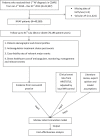Cost-Effectiveness of Apixaban versus Warfarin in Chinese Patients with Non-Valvular Atrial Fibrillation: A Real-Life and Modelling Analyses
- PMID: 27362421
- PMCID: PMC4928891
- DOI: 10.1371/journal.pone.0157129
Cost-Effectiveness of Apixaban versus Warfarin in Chinese Patients with Non-Valvular Atrial Fibrillation: A Real-Life and Modelling Analyses
Abstract
Objectives: Many of the cost-effectiveness analyses of apixaban against warfarin focused on Western populations but Asian evidence remains less clear. The present study aims to evaluate the cost-effectiveness of apixaban against warfarin in Chinese patients with non-valvular atrial fibrillation (NVAF) from a public institutional perspective in Hong Kong.
Methods: We used a Markov model incorporating 12 health state transitions, and simulated the disease progression of NVAF in 1,000 hypothetical patients treated with apixaban/warfarin. Risks of clinical events were based on the ARISTOTLE trial and were adjusted with local International Normalized Ratio control, defined as the time in therapeutic range. Real-life input for the model, including patients' demographics and clinical profiles, post-event treatment patterns, and healthcare costs, were determined by a retrospective cohort of 40,569 incident patients retrieved from a Hong Kong-wide electronic medical database. Main outcome measurements included numbers of thromboembolic and bleeding events, life years, quality-adjusted life years (QALYs) and direct healthcare cost. When comparing apixaban and warfarin, treatment with incremental cost-effectiveness ratio (ICER) less than one local GDP per capita (USD 33,534 in 2014) was defined to be cost-effective.
Results: In the lifetime simulation, fewer numbers of events were estimated for the apixaban group, resulting in reduced event-related direct medical costs. The estimated ICER of apixaban was USD 7,057 per QALY at base-case analysis and ranged from USD 1,061 to 14,867 per QALY under the 116 tested scenarios in deterministic sensitivity analysis. While in probabilistic sensitivity analysis, the probability of apixaban being the cost-effective alternative to warfarin was 96% and 98% at a willingness to pay threshold of USD 33,534 and 100,602 per QALY, respectively.
Conclusions: Apixaban is likely to be a cost-effective alternative to warfarin for stroke prophylaxis in Chinese patients with NVAF in Hong Kong.
Conflict of interest statement
Figures




Similar articles
-
Economic Analysis of Apixaban Therapy for Patients With Atrial Fibrillation From a US Perspective: Results From the ARISTOTLE Randomized Clinical Trial.JAMA Cardiol. 2017 May 1;2(5):525-534. doi: 10.1001/jamacardio.2017.0065. JAMA Cardiol. 2017. PMID: 28355434 Free PMC article.
-
Cost-effectiveness of apixaban versus warfarin and aspirin in Sweden for stroke prevention in patients with atrial fibrillation.Thromb Res. 2014 Aug;134(2):278-87. doi: 10.1016/j.thromres.2014.05.027. Epub 2014 May 26. Thromb Res. 2014. PMID: 24935675
-
Stroke prevention in patients with atrial fibrillation in France: comparative cost-effectiveness of new oral anticoagulants (apixaban, dabigatran, and rivaroxaban), warfarin, and aspirin.J Med Econ. 2014 Aug;17(8):587-98. doi: 10.3111/13696998.2014.923891. Epub 2014 May 29. J Med Econ. 2014. PMID: 24831811
-
Latin American Clinical Epidemiology Network Series - Paper 2: Apixaban was cost-effective vs. acenocoumarol in patients with nonvalvular atrial fibrillation with moderate to severe risk of embolism in Chile.J Clin Epidemiol. 2017 Jun;86:75-83. doi: 10.1016/j.jclinepi.2016.05.018. Epub 2016 Oct 15. J Clin Epidemiol. 2017. PMID: 27756577 Review.
-
Cost-Effectiveness of Novel Oral Anticoagulants for Stroke Prevention in Non-Valvular Atrial Fibrillation.Curr Cardiol Rep. 2015 Aug;17(8):61. doi: 10.1007/s11886-015-0618-4. Curr Cardiol Rep. 2015. PMID: 26081245 Review.
Cited by
-
Direct Medical Cost of Stroke and the Cost-Effectiveness of Direct Oral Anticoagulants in Atrial Fibrillation-Related Stroke: A Cross-Sectional Study.Int J Environ Res Public Health. 2022 Jan 19;19(3):1078. doi: 10.3390/ijerph19031078. Int J Environ Res Public Health. 2022. PMID: 35162102 Free PMC article.
-
Cost-Effectiveness Analysis of Direct-Acting Oral Anticoagulants for Stroke Prevention in Thai Patients with Non-Valvular Atrial Fibrillation and a High Risk of Bleeding.Pharmacoeconomics. 2019 Feb;37(2):279-289. doi: 10.1007/s40273-018-0741-3. Pharmacoeconomics. 2019. PMID: 30387074
-
Cost Effectiveness of Patient Self-Managed Warfarin Compared with Direct Oral Anticoagulants in Atrial Fibrillation: An Economic Evaluation in a Danish Healthcare Sector Setting.Pharmacoecon Open. 2022 Jul;6(4):483-494. doi: 10.1007/s41669-022-00337-3. Epub 2022 Jun 5. Pharmacoecon Open. 2022. PMID: 35665481 Free PMC article.
-
Cost-Effectiveness of Direct Non-Vitamin K Oral Anticoagulants Versus Vitamin K Antagonists for the Management of Patients with Non-Valvular Atrial Fibrillation Based on Available "Real-World" Evidence: The Italian National Health System Perspective.Clin Drug Investig. 2021 Mar;41(3):255-267. doi: 10.1007/s40261-021-01002-z. Epub 2021 Feb 15. Clin Drug Investig. 2021. PMID: 33587284 Free PMC article.
-
Economic evaluation of direct oral anticoagulants (DOACs) versus vitamin K antagonists (VKAs) for stroke prevention in patients with atrial fibrillation: a systematic review and meta-analysis.BMJ Evid Based Med. 2022 Aug;27(4):215-223. doi: 10.1136/bmjebm-2020-111634. Epub 2021 Oct 11. BMJ Evid Based Med. 2022. PMID: 34635480 Free PMC article.
References
-
- Camm AJ, Kirchhof P, Lip GYH, Schotten U, Savelieva I, Ernst S, et al. Guidelines for the management of atrial fibrillation: The Task Force for the Management of Atrial Fibrillation of the European Society of Cardiology (ESC). European Heart Journal. 2010;31(19):2369–429. 10.1093/eurheartj/ehq278 - DOI - PubMed
-
- Tse HF, Wang YJ, Ahmed Ai-Abdullah M, Pizarro-Borromeo AB, Chiang CE, Krittayaphong R, et al. Stroke prevention in atrial fibrillation—an Asian stroke perspective. Heart rhythm: the official journal of the Heart Rhythm Society. 2013;10(7):1082–8. - PubMed
-
- Boccuzzi SJ, Martin J, Stephenson J, Kreilick C, Fernandes J, Beaulieu J, et al. Retrospective study of total healthcare costs associated with chronic nonvalvular atrial fibrillation and the occurrence of a first transient ischemic attack, stroke or major bleed. Current medical research and opinion. 2009;25(12):2853–64. 10.1185/03007990903196422 - DOI - PubMed
-
- De Caterina R, Husted S, Wallentin L, Andreotti F, Arnesen H, Bachmann F, et al. Vitamin K antagonists in heart disease: current status and perspectives (Section III). Position paper of the ESC Working Group on Thrombosis—Task Force on Anticoagulants in Heart Disease. Thrombosis and haemostasis. 2013;110(6):1087–107. 10.1160/TH13-06-0443 - DOI - PubMed
-
- Holbrook AM, Pereira JA, Labiris R, McDonald H, Douketis JD, Crowther M, et al. Systematic overview of warfarin and its drug and food interactions. Archives of internal medicine. 2005;165(10):1095–106. - PubMed
Publication types
MeSH terms
Substances
LinkOut - more resources
Full Text Sources
Other Literature Sources
Medical

